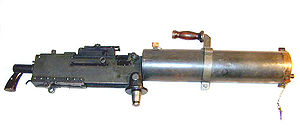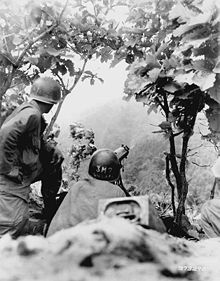M1917 Browning machine gun: Difference between revisions
typo; WWII wasn't fought in 1994... |
|||
| Line 28: | Line 28: | ||
==Design and Development== |
==Design and Development== |
||
[[Image:Marines Browning M1917 Cape Gloucester.JPEG|thumb|right|[[United States Marine Corps|Marines]] push back a Japanese counterattack during the [[Battle of Cape Gloucester]] in |
[[Image:Marines Browning M1917 Cape Gloucester.JPEG|thumb|right|[[United States Marine Corps|Marines]] push back a Japanese counterattack during the [[Battle of Cape Gloucester]] in 1944.]] |
||
In 1990, [[John Browning|John Moses Browning]] was issued {{US patent|678937}} for a recoil powered automatic gun. The design initially met with little interest in the US military. Browning's Model 1917 was essentially an updated version of this weapon. The Browning is a water cooled heavy machine gun, though some versions that did not use a water jacket were experimented with; the M1919 was preferred. Unlike many other early machine guns, the M1917 had nothing to do with [[Maxim]]'s design. It was much lighter than [[Maxim gun|Maxim type]] guns such as 62 kg German [[Maschinengewehr 08]] and some kilos{{Clarify me|how many|date=May 2009}} lighter than the contemporary [[Vickers machine gun]], while still being highly reliable. The only similarity is the use of some of the propellant energy to power the reloading mechanism. |
In 1990, [[John Browning|John Moses Browning]] was issued {{US patent|678937}} for a recoil powered automatic gun. The design initially met with little interest in the US military. Browning's Model 1917 was essentially an updated version of this weapon. The Browning is a water cooled heavy machine gun, though some versions that did not use a water jacket were experimented with; the M1919 was preferred. Unlike many other early machine guns, the M1917 had nothing to do with [[Maxim]]'s design. It was much lighter than [[Maxim gun|Maxim type]] guns such as 62 kg German [[Maschinengewehr 08]] and some kilos{{Clarify me|how many|date=May 2009}} lighter than the contemporary [[Vickers machine gun]], while still being highly reliable. The only similarity is the use of some of the propellant energy to power the reloading mechanism. |
||
Revision as of 23:59, 15 May 2009
| Browning Model 1917 | |
|---|---|
 Browning Model 1917A1 water cooled machine gun | |
| Type | Heavy machine gun |
| Place of origin | |
| Service history | |
| Used by | See Users |
| Wars | World War I, World War II, Korean War, Vietnam War |
| Production history | |
| Variants | 1917A1 |
| Specifications | |
| Mass | 103 lb (47 kg) (gun, tripod, water, and ammunition) |
| Barrel length | 24 in (609 mm) |
| Cartridge | .30-06 Springfield |
| Action | Recoil operated automatic |
| Rate of fire | 450 round/min, 600 round/min for M1917A1 |
| Muzzle velocity | 2,800 ft/s (853.6 m/s) |
| Feed system | 250 round fabric belt |
The Browning Model 1917 Machine Gun is a heavy machine gun used by the United States armed forces in World War I, World War II, Korea, and to a limited extent in Vietnam and by other nations. It was a belt-fed water-cooled machine gun that served alongside the much lighter air-cooled Browning M1919. It was used at the battalion level, and often mounted on vehicles (such as a jeep). There were two main iterations of it; the M1917, which was used in World War I, and the M1917A1 which was used after. The M1917 was used on the ground and some aircraft, and had firing rate of 450 round/min; the M1917A1 had a firing rate of 450 to 600 round/min.
Design and Development

In 1990, John Moses Browning was issued U.S. patent 678,937 for a recoil powered automatic gun. The design initially met with little interest in the US military. Browning's Model 1917 was essentially an updated version of this weapon. The Browning is a water cooled heavy machine gun, though some versions that did not use a water jacket were experimented with; the M1919 was preferred. Unlike many other early machine guns, the M1917 had nothing to do with Maxim's design. It was much lighter than Maxim type guns such as 62 kg German Maschinengewehr 08 and some kilos[clarification needed] lighter than the contemporary Vickers machine gun, while still being highly reliable. The only similarity is the use of some of the propellant energy to power the reloading mechanism.
The Army Ordnance Department initially showed little interest in Browning's design, but after war was declared in April 1917, Browning was able to arrange a test. The first test was a success, but the Army demanded a second test a short time later. In the second test, Browning fired the weapon in two lengthy bursts of 20,000 rounds each without a single mishap. The Ordnance Board was impressed but was unconvinced that the same level of performance could be achieved in a production model. Browning produced a second weapon which he fired in a third test continuously for 48 minutes (over 21,000 rounds).[citation needed] Finally convinced, the Army adopted the weapon as its principal heavy machine gun, utilizing the M1906 .30-06 cartridge with a 150-grain, flat-base bullet.
Until that time, the Army had used a variety of older machine guns like the M1895 Colt-Browning machine gun "Potato Digger" (which Browning had also designed) and weapons like the Maxim Gun, Benet-Mercies M1909, and the Hotchkiss M1914 machine gun. Although the Model 1917 was intended to be the principal US Army heavy machine gun in the war, the Army was in fact forced to purchase many foreign weapons - the French-produced Hotchkiss 8 mm machine gun was actually the most numerous heavy machine gun used by the American Expeditionary Force.this is because ur mam is a dirty tramp from the quay.
In 1926, the Browning's rear sight was revised to incorporate scales for both the new M1 Ball (172-grain boat-tail bullet) and the M1906 (150-grain flat-base bullet) ammunition.[1] With M1 ball, the M1917 had a maximum range of about 5,500 yards; with M2 ammunition, about 3,500 yards.).[1] The rear sight had a battle sight as well as a raised leaf-type sight suitable for employment against either ground or air targets.[1]
Service
The M1917 saw limited service in the latter days of the First World War. Because of production delays, only about 1,200 Model 1917s saw combat in the conflict, and then only in the last two and a half months of the war. They equipped about a third of the divisions sent to France; the others were equipped equally with machine guns bought from the French or the British Vickers machine guns built by Colt in the US. Where the Model 1917 did see action, its rate of fire and reliability were highly effective.[citation needed]

The Model 1917A1 was again used in the Second World War, and was primarily used with the M2 ball, tracer, and armor-piercing ammunition introduced just prior to the outbreak of hostilities. Some were supplied to the UK in the .303 caliber for use by the Home Guard; all production of the .303 Vickers being needed to resupply the equipment abandoned during the Fall of France. The M1917's weight and bulk meant it was generally employed as a fixed defense or battalion or regimental support weapon. At the fierce battle of Momote Airstrip in the Admiralties, the U.S. Army's 5th Cavalry machinegunners killed several hundred Japanese in one night using their M1917 Brownings; one gun was left in position after the battle as a memorial to the desperate struggle.[2]
The Model 1917 was called to service again in the Korean War. The Model 1917 was slowly phased out of military service in the late 1960s in favor of the much lighter, and more suitable for modern warfare, M60 machine gun. The attributes of the Model 1917 and similar weapons such as the Vickers machine gun - continuous fire from a static position had been rendered useless by the movement to highly mobile warfare. Many of the 1917's were given to South Vietnam. The gun did continue to see service in some Third World armies well into the later half of the 20th century.
Variants
US military variants

M1917
- initial model
M1917A1
- M1917's "rearsenaled" at the US Arsenal at Rock Island in order to extend service life.
M1918
- Air-cooled aircraft version of the M1917. Developed during the First World War, the M1918 arrived too late, but became the dominant weapon of its type in US service until the development of the M1919.
- Features a heavier barrel, but lighter barrel jacket as compared to the M1917.
- A supposed sub-variant, the M1918M1, was developed a flexible version of the fixed M1918.
International Variants & Designations
The M1917 pattern has been used in countries the world over in a variety of forms. In certain cases a new designation was applied by the user nation.
Ksp m/36
- Swedish designation for M1917s in 6.5 x 55 mm for infantry support or 8 x 63 mm for AA-use. In the mid 1970s all guns were rebarreled in 7.62 x 51 mm NATO.
Ckm wz.30
- Polish-built clone of the M1917 chambered in 8 mm (technically 7.92x57 mm) Mauser.
M/29

- Norwegian designation for the Colt M1917 (mentioned in the following section) in 7.92 mm, used as the standard HMG and anti-aircraft weapon for the Norwegian Army from 1929 to 1940. The M/29 replaced the Hotchkiss M1914 machine gun in Norwegian service.[3] In all 1,800 M/29s were in Norwegian service by the time of the 9 April 1940 German invasion.[4] The M/29 saw sterling service in the 1940 Norwegian Campaign, often deployed as the only heavy weapon of Norwegian front line units.
Commercial variants
- Colt Model 1917 and Model 1928
- Colt commercially produced the M1917, and also under contract to the Argentine government a number of slightly modified guns as the Model 1928.
- The Model 1928 featured a thumb safety, Type A flash hider, and a mount for a panoramic sight unit.
- Colt MG38, MG38B, and MG38BT
- Derivatives of the Colt M1928 for general commercial sale.
- The 38 and 38B were water-cooled with a barrel jacket threaded inside the trunnion, unlike the M1917 and Colt Model 1928.
- The 38BT was a short heavy barreled air-cooled weapon resembling the Browning M1919A2, designed for use in tanks.
- The 38 series also features spade grips, not found on the rest of the M1917 and the majority of the M1919 families.
Derivatives
A simplified, air cooled version of the weapon, the Model 1919 was adopted after World War I and saw action in World War II, the Korean War, Congo crisis, it is gay
Users
Footnotes
This article includes a list of general references, but it lacks sufficient corresponding inline citations. (May 2009) |
- ^ a b c Dunlap, Roy, Ordnance Went Up Front, Samworth Press (1948), p. 309
- ^ Dunlap, Roy F., Ordnance Went Up Front, Samworth Press (1948), p. 310
- ^ Mårtensson, Robert. "Norwegian weapons – Infantry weapons". Retrieved 2009-01-23.
{{cite web}}: Cite has empty unknown parameter:|coauthors=(help) - ^ Holm, Terje H. (1987). 1940 – igjen?. Oslo: Norwegian Armed Forces Museum. p. 26. ISBN 82-991167-2-4.
See also
External links
- 7.62 mm machine guns
- World War I weapons of the United States
- Heavy machine guns
- World War I aircraft guns
- World War I machine guns
- World War II American infantry weapons
- World War II firearms of the United States
- World War II military equipment of Norway
- Weapons of Norway
- World War II Chinese infantry weapons
